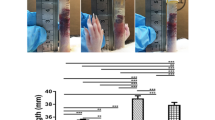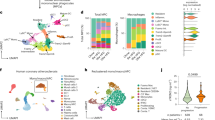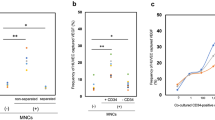Abstract
Endothelial progenitor cells (EPCs) play an important role in endothelial vascular development and endothelial repair. The upregulation of functional gene expression in EPCs may contribute to the maintenance of EPC-based endothelial repair. Peroxisome proliferator-activated receptor-γ coactivator-1α (PGC-1α) is a powerful regulator of mitochondrial biogenesis and antioxidant defense, but its impact on early EPCs remains poorly understood. This study was designed to investigate whether decline in PGC-1α expression impairs in vitro adhesion, migration, and in vivo reendothelialization capacity of early EPCs from patients with hypertension. We engineered an over-expression of PGC-1α within EPCs from hypertensive patients, which were transduced with an adenoviral vector encoding the human PGC-1α gene. Then we tested the migration and adhesion function of EPCs in vitro and endothelium-reparative capacity in vivo with a nude mouse model of carotid artery injury. Our data revealed for the first time that PGC-1α expression of EPCs is lower in hypertensive patients than that in healthy subjects. Meanwhile, the in vitro adhesion and migration function, in vivo endothelial repair capacity of early EPCs were significantly reduced in hypertensive patients compared with normal subjects. Furthermore, PGC-1α gene transfer contributes to increased adhesion in vitro and enhanced endothelium-reparative capacity in vivo of EPCs from hypertensive patients through the augmented expression of PGC-1α. Thus, upregulation of PGC-1α expression of EPCs may be a novel complementary therapeutic target to increase endothelium-reparative capacity in hypertensive patients.
This is a preview of subscription content, access via your institution
Access options
Subscribe to this journal
Receive 12 digital issues and online access to articles
$119.00 per year
only $9.92 per issue
Buy this article
- Purchase on Springer Link
- Instant access to full article PDF
Prices may be subject to local taxes which are calculated during checkout


Similar content being viewed by others
References
Brandes RP. Endothelial dysfunction and hypertension. Hypertension. 2014;64:924–8.
Luo S, Xia W, Chen C, Robinson EA, Tao J. Endothelial progenitor cells and hypertension: current concepts and future implications. Clin Sci. 2016;130:2029–42.
Hristov M, Erl W, Weber PC. Endothelial progenitor cells. Arterioscler, Thromb, Vasc Biol. 2003;23:1185–9.
Giannotti G, Doerries C, Mocharla PS, Mueller MF, Bahlmann FH, Horvàth T, et al. Impaired endothelial repair capacity of early endothelial progenitor cells in prehypertension. Hypertension. 2010;55:1389–97.
Zhang X, Su C, Cao Z, Xu S, Xia W, Xie W, et al. CXCR7 upregulation is required for early endothelial progenitor cell–mediated endothelial repair in patients with hypertension. Hypertension. 2014;63:383–9.
Liu X, Zhang G, Zhang X, Xia W, Yang Z, Su C, et al. Lacidipine improves endothelial repair capacity of endothelial progenitor cells from patients with essential hypertension. Int J Cardiol. 2013;168:3317–26.
Rowe GC, Jiang A, Arany Z. PGC-1 coactivators in cardiac development and disease. Circ Res. 2010;107:825–38.
Valle I, Alvarezbarrientos A, Arza E, Lamas S, Monsalve M. PGC-1α regulates the mitochondrial antioxidant defense system in vascular endothelial cells. Cardiovasc Res. 2005;66:562–73.
Das A, Huang GX, Bonkowski MS, Longchamp A, Li C, Schultz MB, et al. Impairment of an endothelial NAD+-H2S signaling network is a reversible cause of vascular aging. Cell. 2018;173:74–89.
Zhang Y, Wang C, Jin Y, Yang Q, Meng Q, Liu Q, et al. Activating the PGC-1α/TERT pathway by catalpol ameliorates atherosclerosis via modulating ROS production, DNA damage, and telomere function: implications on mitochondria and telomere link. Oxid Med Cell Longev. 2018;2018:1–16.
Kadlec AO, Chabowski DS, Ait-Aissa K, Gutterman DD. Role of PGC-1α in vascular regulation. Arterioscler, Thromb, Vasc Biol. 2016;36:1467–74.
Shimba Y, Togawa H, Senoo N, Ikeda M, Miyoshi N, Morita A, et al. Skeletal muscle-specific PGC-1α overexpression suppresses atherosclerosis in apolipoprotein E-knockout mice. Sci Rep. 2019;9:4077.
Xiong S, Patrushev N, Forouzandeh F, Hilenski L, Alexander RW. PGC-1α modulates telomere function and DNA damage in protecting against aging-related chronic diseases. Cell Rep. 2015;12:1391–9.
Kadlec AO, Chabowski DS, Ait-Aissa K, Hockenberry JC, Otterson MF, Durand MJ, et al. PGC-1α (peroxisome proliferator–activated receptor γ coactivator 1-α) overexpression in coronary artery disease recruits no and hydrogen peroxide during flow-mediated dilation and protects against increased intraluminal pressure. Hypertension. 2017;70:166–73.
Xiong S, Salazar G, Patrushev N, Ma M, Forouzandeh F, Hilenski L, et al. Peroxisome proliferator-activated receptor γ coactivator-1α is a central negative regulator of vascular senescence. Arterioscler, Thromb, Vasc Biol. 2013;33:988–98.
Chen L, Ding M, Wu F, He W, Li J, Zhang X, et al. Impaired endothelial repair capacity of early endothelial progenitor cells in hypertensive patients with primary hyperaldosteronemia. Hypertension. 2016;67:430–9.
Xia W, Chen L, Liang J, Zhang X, Su C, Tong X, et al. BMP4/Id2 signaling pathway is a novel therapeutic target for late outgrowth endothelial progenitor cell-mediated endothelial injury repair. Int J Cardiol. 2017;228:796–804.
Tsai T, Lee C, Cheng C, Fang Y, Chung S, Chen S, et al. Liraglutide inhibits endothelial-to-mesenchymal transition and attenuates neointima formation after endovascular injury in streptozotocin-induced diabetic mice. Cells-Basel. 2019;8:589.
Sharma J, Johnston MV, Hossain MA. Sex differences in mitochondrial biogenesis determine neuronal death and survival in response to oxygen glucose deprivation and reoxygenation. BMC Neurosci. 2014;15:9.
Kröller-Schön S, Jansen T, Schüler A, Oelze M, Wenzel P, Hausding M, et al. Peroxisome proliferator-activated receptor γ, coactivator 1α deletion induces angiotensin II–associated vascular dysfunction by increasing mitochondrial oxidative stress and vascular inflammation. Arterioscler, Thromb, Vasc Biol. 2013;33:1928–35.
Patten IS, Arany Z. PGC-1 coactivators in the cardiovascular system. Trends Endocrinol Metab. 2012;23:90–7.
Zhao Q, Zhang J, Wang H. PGC-1α overexpression suppresses blood pressure elevation in DOCA-salt hypertensive mice. Biosci Rep. 2015;35:e00217.
Lee G, Uddin MJ, Kim Y, Ko M, Yu I, Ha H. PGC-1A, a potential therapeutic target against kidney aging. Aging Cell. 2019;18:1–19.
Yu B, Huo L, Liu Y, Deng P, Szymanski J, Li J, et al. PGC-1α controls skeletal stem cell fate and bone-fat balance in osteoporosis and skeletal aging by inducing TAZ. Cell Stem Cell. 2018;23:193–209.
Fang EF, Scheibye-Knudsen M, Brace LE, Kassahun H, SenGupta T, Nilsen H, et al. Defective mitophagy in XPA via PARP-1 hyperactivation and NAD+/SIRT1 reduction. Cell. 2014;157:882–96.
Vasileiou PVS, Evangelou K, Vlasis K, Fildisis G, Panayiotidis MI, Chronopoulos E, et al. Mitochondrial homeostasis and cellular senescence. Cells. 2019;8:686.
He J, Liu X, Su C, Wu F, Sun J, Zhang J, et al. Inhibition of mitochondrial oxidative damage improves reendothelialization capacity of endothelial progenitor cells via SIRT3 (Sirtuin 3)-enhanced SOD2 (Superoxide Dismutase 2) deacetylation in hypertension. Arterioscler, Thromb, Vasc Biol. 2019;39:1682–98.
Vainshtein A, Desjardins EM, Armani A, Sandri M, Hood DA. PGC-1α modulates denervation-induced mitophagy in skeletal muscle. Skelet Muscle. 2015;5.
Sawada N, Jiang A, Takizawa F, Safdar A, Manika A, Tesmenitsky Y, et al. Endothelial PGC-1α mediates vascular dysfunction in diabetes. Cell Metab. 2014;19:246–58.
Zhao Q, Zhang J, Wang H. PGC-1 limits angiotensin II-induced rat vascular smooth muscle cells proliferation via attenuating NOX1-mediated generation of reactive oxygen species. Biosci Rep. 2015;35:e252.
García-Quintans N, Prieto I, Sánchez-Ramos C, Luque A, Arza E, Olmos Y, et al. Regulation of endothelial dynamics by PGC-1α relies On ROS control of VEGF—a signaling. Free Radic Bio Med. 2016;93:41–51.
Chen D, Xia Y, Zuo K, Wang Y, Zhang S, Kuang D, et al. Crosstalk between SDF-1/CXCR4 and SDF-1/CXCR7 in cardiac stem cell migration. Sci Rep. 2015;5:16813.
Dai X, Tan Y, Cai S, Xiong X, Wang L, Ye Q, et al. The role of CXCR7 on the adhesion, proliferation and angiogenesis of endothelial progenitor cells. J Cell Mol Med. 2011;15:1299–309.
He T, Peterson TE, Holmuhamedov EL, Terzic A, Caplice NM, Oberley LW, et al. Human endothelial progenitor cells tolerate oxidative stress due to intrinsically high expression of manganese superoxide dismutase. Arterioscler, Thromb, Vasc Biol. 2004;24:2021–7.
Dernbach E. Antioxidative stress-associated genes in circulating progenitor cells: evidence for enhanced resistance against oxidative stress. Blood. 2004;104:3591–7.
Acknowledgements
The work was supported financially by the National Nature Science Foundation (31530023, 81500205) of China.
Author information
Authors and Affiliations
Corresponding authors
Ethics declarations
Conflict of interest
The authors declare that they have no conflict of interest.
Additional information
Publisher’s note Springer Nature remains neutral with regard to jurisdictional claims in published maps and institutional affiliations.
Supplementary information
Rights and permissions
About this article
Cite this article
Xie, W., Wu, F., He, J. et al. PGC-1α gene transfer restores adhesion and reendothelialization of endothelial progenitor cells from patients with hypertension. J Hum Hypertens 35, 510–516 (2021). https://doi.org/10.1038/s41371-020-0364-y
Received:
Revised:
Accepted:
Published:
Issue Date:
DOI: https://doi.org/10.1038/s41371-020-0364-y



